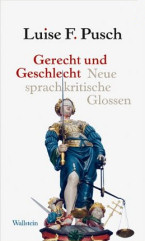
born September 12, 1873 in Hohenlimburg (now part of Hagen), Germany
died March 25, 1954 in Bethel near Bielefeld, Germany
German women's rights activist, politician and writer
150th birthday on September 12, 2023
Biography
For three decades, from 1900 on, Gertrud Bäumer stood with Helene Lange at the head of the “moderate wing” of the bourgeois women's movement in Germany. Together they edited the monthly journal Die Frau and the Handbuch der Frauenbewegung. Today many high schools in Germany bear Lange's or Bäumer's name, for they campaigned for equal rights particularly in the areas of women's education, training and employment. As a politician, Bäumer worked in the Reichstag (parliament), the Ministry of the Interior and the League of Nations. When she was dismissed from these posts in 1933, she turned to writing and experienced equal success as an author.
Gertrud Bäumer was born in Hohenlimburg, now a district of Hagen, in 1873. Her paternal ancestors spanned “generations of pastors.” Her father Emil was a pastor who however had to serve in schools, due to “his frank and audacious views,” which were at odds with official church doctrine. “Our mother was - the mother.” (Bäumer, Lebensweg 10) Emil and Caroline Bäumer, née Schede, had three children. Gertrud was the eldest; her siblings Carl and Elisabeth (nicknamed Else) were born one year apart, Carl in 1874 and Elisabeth in 1875. “Typical for the children of a civil servant” with the father “transferred,” and then “transferred yet again,” they had no childhood roots in any one locale. (Lebensweg 10/11).
In 1876, her father was transferred to Cammin in Pomerania and Gertrud spent the next few happy and carefree years in a house high above the lagoon with a sweeping view over the water.
When she was about 8 years old, they moved back west to Mülheim an der Ruhr.
The following year her father fell ill and died at age 36 of a kidney disease. Unable to live on a widow’s pension, Gertrud's mother decided to return with the three children to Halle an der Saale to live with her mother, the widow of a legal counsellor. An older sister, Gertrud’s widowed aunt, had also sought refuge there with her two children. Bäumer later remarked that these “childhood years in her grandmother's house” had a lasting effect on her; she was influenced “not so much by persons as by the strangely pervasive ambience, a certain frame of mind and attitude typical for a dignified family of civil servants.” (Lebensweg 39)
Intent on earning a living to ensure her own financial independence, she attended Halle’s Höhere Töchterschule, a secondary school for girls, with the aim of becoming a teacher. She rejected the economic dependency her mother had experienced as well as her cousin’s approach, spending her days on self-absorbed issues such as what to wear to the next ball in order to attract a suitable husband..
Thus Bäumer focused early, while still a schoolgirl, on the issue of education, just as activists in the bourgeois women's movement in Germany at the time concentrated their efforts on expanding women's educational opportunities rather than on women’s suffrage.
After obtaining her qualifications, Bäumer took up a teaching post in Kamen, Westphalia, at the age of 19. An older female colleague explained who Helene Lange was and gave her an issue of Die Lehrerin (The Woman Teacher), Lange’s periodical for female teachers. After a brief and difficult interlude at a girls' elementary school in Magdeburg, where she was the only female teacher, Bäumer began teaching in 1895 at a private secondary school for girls that had a young, all-female faculty. She founded a teachers' association with her colleagues there and was elected to the board. These two years of teaching experience at a girls’ secondary school were one of the prerequisites for women who wanted to attend university courses.
Gertrud Bäumer went to Berlin in 1898 for her further training as a senior teacher, which was the second requirement for any woman wishing to gain entrance to a university. She passed the final exam in the spring of 1900 and immediately began her studies of theology, German language and literature, and philosophy with Adolf von Harnack, Erich Schmidt and Wilhelm Dilthey. These three men were reasonably tolerant of women students and Bäumer was therefore allowed to attend their classes. Women in Prussia did not gain regular access to universities until 1908, by which time Bäumer had long since received her doctorate (1904, on Goethe) and had co-edited the five-volume opus on the women’s movement (Handbuch der Frauenbewegung, 1901-1906) together with Helene Lange.
Helene Lange (1848-1930) was undoubtedly the leader of the women's movement in 1898, when Bäumer arrived in Berlin at the age of 24. But when Lange developed an eye disease accompanied by severe migraines that left her unable to work for days, fellow activists recommended Bäumer as an assistant. Bäumer passionately immersed herself in the work and was soon deemed indispensable. In 1899, Bäumer and Lange moved in together; Lange's partner, Dora Sommer, who had previously managed the household, had to give way to Bäumer. Lange and Bäumer maintained a simple but refined domesticity that included a maid and music. Both were music lovers; they sang and played the piano. Apart from that they worked tirelessly in the women’s movement, supporting and encouraging each other, so that together they soon formed the extremely effective ‘dream team’ of the movement. The exact nature of their relationship and their feelings for each other remain unknown; details from their private lives remained under lock and key as at the time male sexologists were beginning to view the hitherto respectable Boston marriage as “unnatural.”
Perhaps conclusions can be drawn from Bäumer's second partnership with the writer Gertrud von Sanden (1883-1940). The two women met in 1921 and moved in together in 1930 following Helene Lange's death. Under the pseudonym M.B. Kennicott, Von Sanden wrote a roman à clef in epistolary form, Das Herz ist wach (The Heart is Awake, 1934), about her relationship with Bäumer. To describe the novel as “emotional, almost effusive” (Reicke) is an understatement; it actually packs an incredibly passionate punch. The two correspondents, a diplomat (female) and a much older, wealthy squire and esthete (male), are madly in love with each other and declare their burning desire and eternal love for each other in letter after letter over the entire 300 pages. The relationship is purely platonic with only a chaste kiss exchanged once in the moonlight, but the steamy passion between the two is palpable. This is how lesbians tend to feel, I thought while reading the novel, especially when they are not allowed to act on their feelings. The book remained extremely popular into the 1950s, likely providing many female readers with material they sorely missed in their own lives.
Helene Lange mentored the highly motivated, multi-talented and charismatic Gertrud Bäumer, who thus experienced a whirlwind career up the ranks of the women's movement. Some of the older comrades-in-arms felt pushed aside in favor of the woman Lange had chosen as her successor. Already in 1899 Lange had arranged for Bäumer to be elected to the board of the national women teachers’ association (ADLV, Allgemeiner deutscher Lehrerinnenverein); the two began to co-edit the monthly periodical founded in 1893 by Lange, Die Frau; Bäumer was chairwoman of the Federation of German Women's Associations from 1910 until 1919 and then deputy chairwoman from 1919 until the voluntary liquidation of the association in 1933.
As if that were not enough, Bäumer also began to collaborate with her close friend and supporter Friedrich Naumann, one of the fathers of German liberalism, and together they edited the journal Die Hilfe starting in 1912. During World War I, Bäumer supported the nation by founding and directing the National Women's Service, which assisted war widows and orphans and organized the work of women on the “home front.” Meanwhile, Anita Augspurg and Lida Gustava Heymann, the two leaders of the radical wing of the women's movement and radical pacifists whose demands remain relevant today, initiated and organized the International Women's Peace Congress in 1915 in The Hague.
In 1916, in the middle of the war, Bäumer and Lange moved to Hamburg. Together with Marie Baum, Bäumer set up the Women's College of Social Work and the Social Pedagogical Institute in 1917 (since 1970 both are part of the Hamburg University of Applied Sciences).
During the war women had not only seen to the daily “women’s work,” but had also successfully taken on all the “men's work” on the “home front.” Thus by 1918 they could no longer be denied the right to vote. Bäumer was elected to the Reichstag for the DDP (German Democratic Party, the precursor of today's Free Democratic Party) founded by Naumann. She also became Germany's first Ministerialrätin (female undersecretary), in the Ministry of the Interior, where she was responsible for schools and child welfare. From 1926 until 1933, she was a delegate to the League of Nations in Geneva.
Bäumer lost all political offices in 1933 with the onset of Nazi rule. “Released” from these duties, she wrote her autobiography, Lebensweg durch eine Zeitenwende (A Life's Path Crossing the Threshold to a New Age), in three months.
She withdrew to Gießmannsdorf Castle in Silesia with her new partner Gertrud von Sanden and earned her living by writing books and by travelling to give lectures and readings. She wrote mainly historical novels, including one about Adelheid: Mutter der Königreiche (Mother of the Kingdoms, 1936) and one about Adelheid’s grandson Otto III, Der Jüngling im Sternenmantel (The Youth in the Coat of Stars,1938). These very successful books could be read as criticism of the Nazi regime but they could also “be used as Nazi propaganda.” In this respect, they were typical of the literature of inner emigration (Schaser 1997:24). Ingeborg Drewitz remarked 45 years later: “The psychological and historical accuracy is convincing. We have a harder time with her language. She uses the elevated literary language oriented to the classical model, which is, after all, in general use until the early fifties.” Indeed, Bäumer's pathos is annoying at times; however, she could also be direct and straightforward when she was not intent on producing “literature.” In her letters, for example, she expressed herself clearly, sincerely and vividly.
Bäumer repeatedly came into conflict with Goebbels’ Chamber of Culture (Reichschrifttumskammer). On the one hand, she was a women's rights activist and therefore an obvious suspect for the regime; on the other hand, such a prominent intellectual could perhaps be persuaded and then used for Nazi propaganda. Die Frau was allowed to continue publishing, but only under the conditions imposed by the Nazis. Many of the old comrades-in-arms would have preferred a clear break with the regime; they therefore accused Bäumer of compromising, and even collaborating, with the Nazis.
According to the historian Angelika Schaser, Bäumer “can neither be convincingly stylized as an activist in the German resistance like the July 20 plotters, nor can the term 'active National Socialist' be used to describe her. The form of resistance she thought she was expressing posed no danger to the regime. Her attitude is probably best captured in the paradoxical term 'conformist resistance'.” (1997:23)
In 1948, at the age of 75, Gertrud Bäumer fell ill with arteriosclerosis and dementia. She had to abandon her lecture tours, and she was cared for by her sister Else in Bad Godesberg. “The terrible ending of a commanding life” (Theodor Heuss) took its course. At the end of 1953 she entered a nursing home in Bethel; she died there on March 25, 1954 at the age of 80.
(Text from 2022, translated with DeepL.com; edited by Ramona Fararo, 2023)
Please consult the German version for additional information (pictures, sources, videos, bibliography).
Author: Luise F. Pusch
If you hold the rights to one or more of the images on this page and object to its/their appearance here, please contact Fembio.



